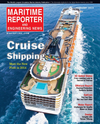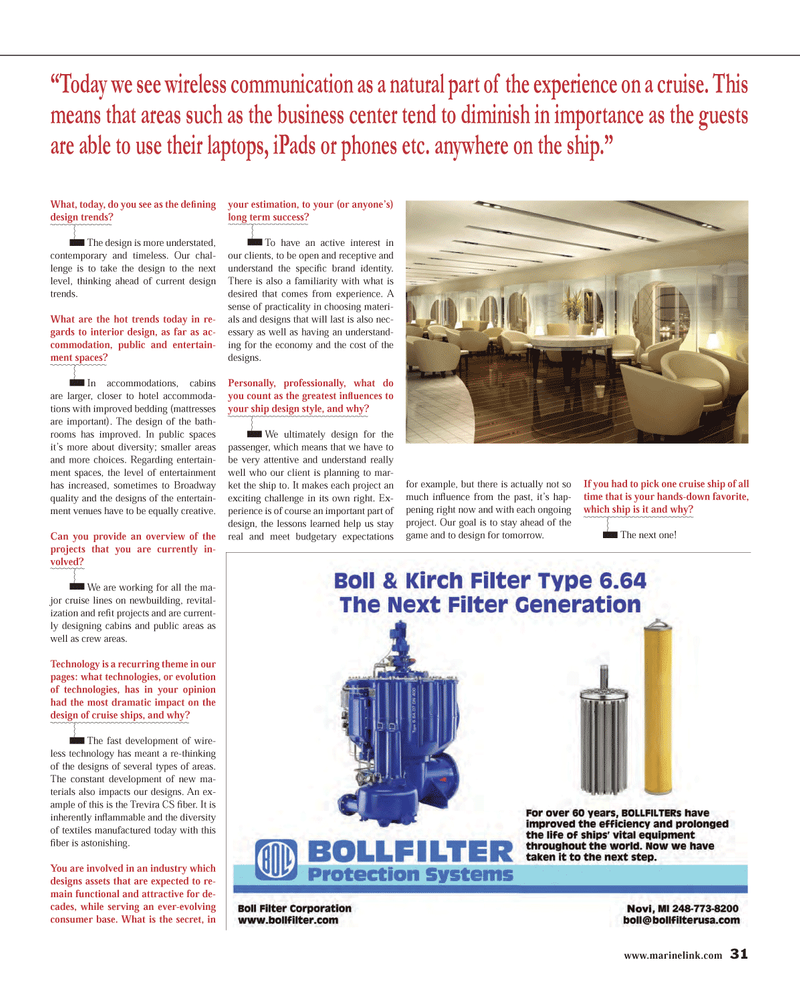
Page 31: of Maritime Reporter Magazine (February 2014)
Cruise Shipping Edition
Read this page in Pdf, Flash or Html5 edition of February 2014 Maritime Reporter Magazine
www.marinelink.com 31
What, today, do you see as the defi ning design trends? The design is more understated, contemporary and timeless. Our chal- lenge is to take the design to the next level, thinking ahead of current design trends.
What are the hot trends today in re- gards to interior design, as far as ac- commodation, public and entertain- ment spaces? In accommodations, cabins are larger, closer to hotel accommoda- tions with improved bedding (mattresses are important). The design of the bath- rooms has improved. In public spaces it’s more about diversity; smaller areas and more choices. Regarding entertain- ment spaces, the level of entertainment has increased, sometimes to Broadway quality and the designs of the entertain- ment venues have to be equally creative.
Can you provide an overview of the projects that you are currently in- volved? We are working for all the ma- jor cruise lines on newbuilding, revital- ization and refi t projects and are current- ly designing cabins and public areas as well as crew areas.
Technology is a recurring theme in our pages: what technologies, or evolution of technologies, has in your opinion had the most dramatic impact on the design of cruise ships, and why? The fast development of wire- less technology has meant a re-thinking of the designs of several types of areas.
The constant development of new ma- terials also impacts our designs. An ex- ample of this is the Trevira CS fi ber. It is inherently infl ammable and the diversity of textiles manufactured today with this fi ber is astonishing.
You are involved in an industry which designs assets that are expected to re- main functional and attractive for de- cades, while serving an ever-evolving consumer base. What is the secret, in your estimation, to your (or anyone’s) long term success? To have an active interest in our clients, to be open and receptive and understand the specifi c brand identity.
There is also a familiarity with what is desired that comes from experience. A sense of practicality in choosing materi- als and designs that will last is also nec- essary as well as having an understand- ing for the economy and the cost of the designs.
Personally, professionally, what do you count as the greatest infl uences to your ship design style, and why? We ultimately design for the passenger, which means that we have to be very attentive and understand really well who our client is planning to mar- ket the ship to. It makes each project an exciting challenge in its own right. Ex- perience is of course an important part of design, the lessons learned help us stay real and meet budgetary expectations for example, but there is actually not so much infl uence from the past, it’s hap- pening right now and with each ongoing project. Our goal is to stay ahead of the game and to design for tomorrow.
If you had to pick one cruise ship of all time that is your hands-down favorite, which ship is it and why? The next one! “Today we see wireless communication as a natural part of the experience on a cruise. This means that areas such as the business center tend to diminish in importance as the guests are able to use their laptops, iPads or phones etc. anywhere on the ship.”
MR #2 (26-31).indd 31 2/3/2014 10:14:44 AM

 30
30

 32
32
